May 17, 2019
Experience the best summer festivals in Tokyo’s shitamachi
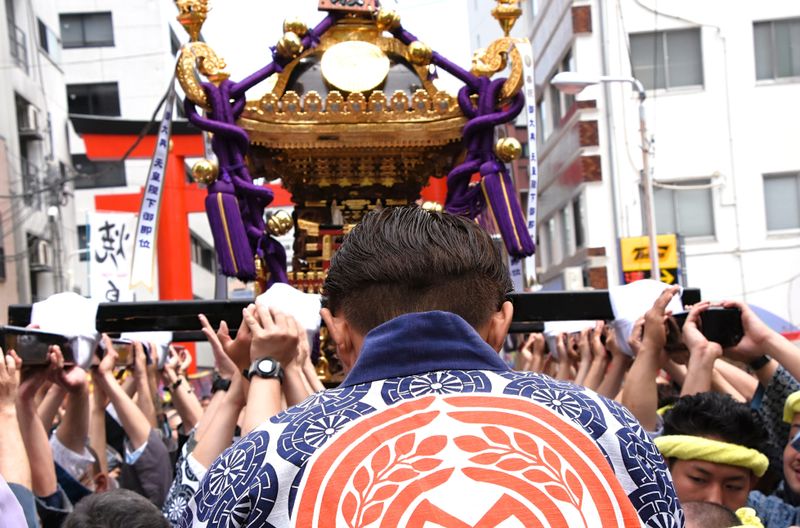
Tokyo’s Taito City, famous for its shitamachi culture and the sights of Asakusa and Ueno, is also host to some of the biggest and best festivals Tokyo has to offer. These festivals, or matsuri, offer visitors the chance to get in amongst the excited throngs to observe authentic Japanese tradition and traditional costume set against a backdrop of spectacular shrines and streetscapes.
Being at the heart of Edo, the former name of Tokyo, many of Taito City’s biggest festivals are held from May and into the summer, reflecting their urban nature (where rural festivals in Japan would traditionally be held in the fall to celebrate the season’s rice harvest).
The festival season starts here …
Shitaya Jinja Taisai (下谷神社大祭) is often missing on the Tokyo traveler’s itinerary, and that’s a shame, as this matsuri is arguably as authentic as they come, considered by locals to be the curtain-raiser for the season of summer festivals in this part of Tokyo -- “Festivals of Edo begin with Shitaya,” so the saying goes.
Shitaya Jinja Taisai - Friday May 10 - Sunday May 12, 2019
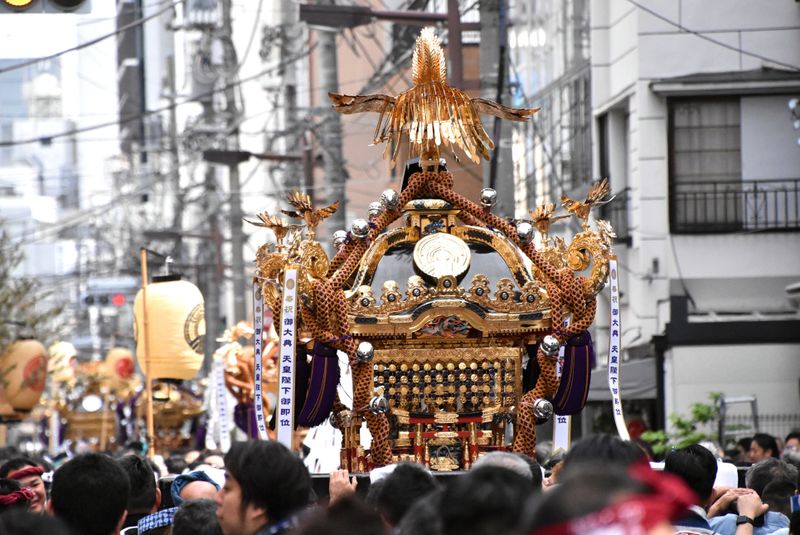
Centering around Shitaya Shrine (once Tokyo’s largest inari shrine) a few blocks east of Ueno Station in the charming neighborhood of Shitaya, the three-day Shitaya Jinja Taisai (Shitaya Shrine Festival) brings out the shrine’s main mikoshi -- a portable shrine bearing the local deity -- on years of an even number. On years of an odd number attention is turned to the mikoshi belonging to neighborhood associations.
For this year’s matsuri, Reiwa 1, locals brought out all the bells and whistles to lay on a festive extravaganza in honor of the new era in Japan, after Emperor Naruhito’s accession to the throne on May 1. Not just the first of the shitamachi festivals of the summer then, but the first to celebrate the Reiwa Era.
Locals described scenes on the festival’s final Sunday as “historic” when all 29 of the town’s neighborhood mikoshi, and their teams of 200 - 300 bearers, lined up along Asakusa-dori to form an impressive and festive column stretching toward the distant Tokyo Skytree. Mikoshi were waiting their turn -- bearers breaking out into excited chatter in the meantime -- to make a straining, passionate approach to the shrine’s entrance where the chief priest was waiting to bestow his blessings before sending the mikoshi back home … until next year.
Festival insight
Despite the local atmosphere that abounds during Shitaya Jinja Taisai most of the neighborhood mikoshi were made in the city of Gyotoku, Chiba Prefecture, something of a center for mikoshi production. To this day, completed mikoshi are transported from Gyotoku toward Tokyo along a waterway built, primarily for the transportation of salt, during the reign of Shogun Tokugawa Ieyasu.
For more details: https://authentic-tokyo.com/event/detail?event_id=1000055?referrer=cc_article
Sanja Matsuri - Friday May 17 - Sunday May 19, 2019

One of the largest, and most storied, of festivals in all of Tokyo, Sanja Matsuri (三社祭) is a must-see.
Held in celebration of the three founders of Tokyo’s oldest temple Sensoji, in the city’s Asakusa district, Sanja Matsuri is the authentic Japanese festival experience writ large, taking all of the trademark matsuri elements and delivering them on an emphatic scale. The result is a weekend of passion, sweat, straining crowds, magnificent mikoshi, guttural festive cries, colorful clothing, unique haircuts, drink, grilled food, and enough jaw-dropping photo opportunities to bring down social media.
Sanja Matsuri moves through the gears as it moves through the festival program. Starting out on the Friday afternoon with the moving Daigyoretsu, a parade of priests, geigi (more commonly known as geisha), dancers and dignitaries that slowly moves through the streets of Asakusa, down Nakamise-dori, coming to a stop at Asakusa Shrine.
Around noon on the Saturday 100 mikoshi from the 44 neighborhoods of Asakusa are paraded through the streets on their way to the square in front of Sensoji Temple where they await their turn to be blessed at Asakusa Shrine.
Things start much earlier on the final Sunday of Sanja Matsuri with the three mikoshi from Asakusa Shrine (representing the Sensoji founders) setting out at around 6:00 am on a circuitous course around Asakusa before being brought back to the shrine in the evening.
Festival insight
For those who aren’t afraid of crowds, squeezing into the square in front of Sensoji Temple on the Saturday will provide some great photos of the neighborhood mikoshi floating on a sea of outstretched arms. Stay alert though, the mikoshi and their bearers can sway dramatically and anyone in the way will be told so in no uncertain terms. Calmer mikoshi viewing can be enjoyed nearby in the narrow lanes west of the Sensoji complex.
More details: https://authentic-tokyo.com/event/detail?event_id=1000052?referrer=cc_article
Torikoe Matsuri - Saturday June 8 - Sunday June 9, 2019
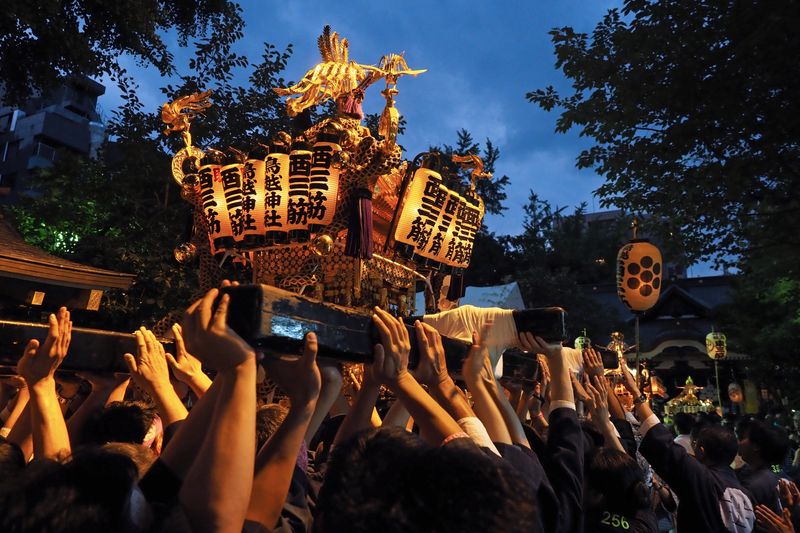
Festival goers who’ve had the chance to participate in the bearing of a matsuri mikoshi will know that even when shared between a team of grown-ups, these things are incredibly heavy. And you really do feel it!
Visitors to the Torikoe Matsuri (Torikoe Shrine Festival / 鳥越祭り) then, can look on in admiration as locals bear the burden of the heaviest mikoshi in Tokyo. Torikoe Shrine’s near four-tonne “sengan-mikoshi” gets an airing once a year during this festival which takes place over two days in Torigoe, south of Asakusa Station.
On the festival’s final day teams of bearers from each of the town’s neighborhoods take turns to carry the weighty sengan-mikoshi in a parade headed up by people dressed in costumes that include the Shinto deity Sarutahiko as well as those dressed in tekomai costume.
Festival insight
Be sure to stick around after dark for the Torikoe Night Festival. During this climactic event the festival atmosphere is lit with traditional paper lanterns creating an intoxicating mood for the “miyari,” the return of the mikoshi to the shrine grounds.
More details: https://authentic-tokyo.com/event/detail?event_id=1000056?referrer=cc_article
Sumida River Fireworks Festival - Saturday July 27, 2019
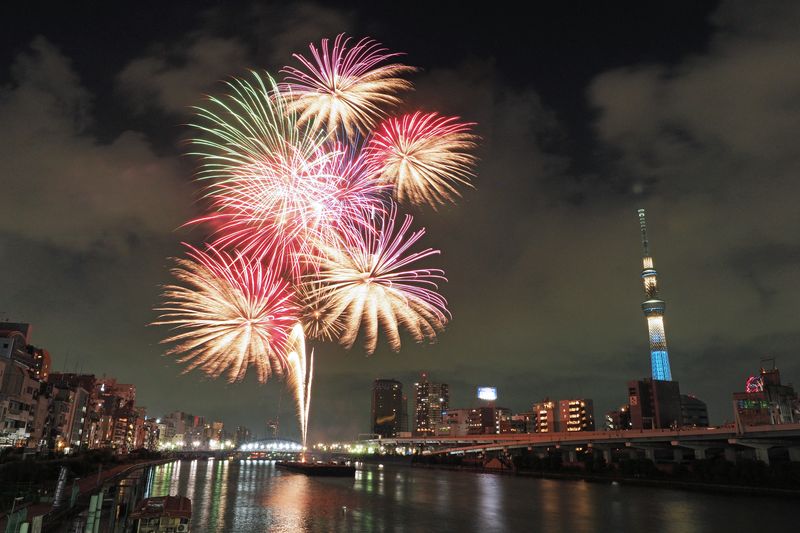
The Japanese have been staring skyward to “Ooh” and “Aah” over fireworks -- "hanabi" (literally, "fire flowers”) in Japanese -- for centuries, with hanabi taikai, or fireworks contests, an essential event on any summer calendar.
According to some, this is where it all started, at least on a large and festive scale, Sumida River Fireworks Festival (隅田川花火大会), the oldest fireworks festival in Japan.
Dating back to 1733, Sumida River Fireworks Festival has grown to take place on an impressive scale regularly attracting nearly one million visitors to the banks of the Sumida River. Even more impressive is the display of pyrotechnics produced by over 20,000 rockets launched from two points on the river.
Festival insight
Despite the festive atmosphere and dazzling pyrotechnics Sumida River Fireworks Festival is actually rooted in something quite sombre having started out as the Water God Festival during the Edo Era. The festival was organized under the orders of the then Shogun Tokugawa Yoshimune as an occasion to pray for the souls of the victims who perished during a famine and resulting plague the previous year.
More details: https://authentic-tokyo.com/event/detail?event_id=1000060?referrer=cc_article
Asakusa Samba Carnival - Saturday August 31, 2019
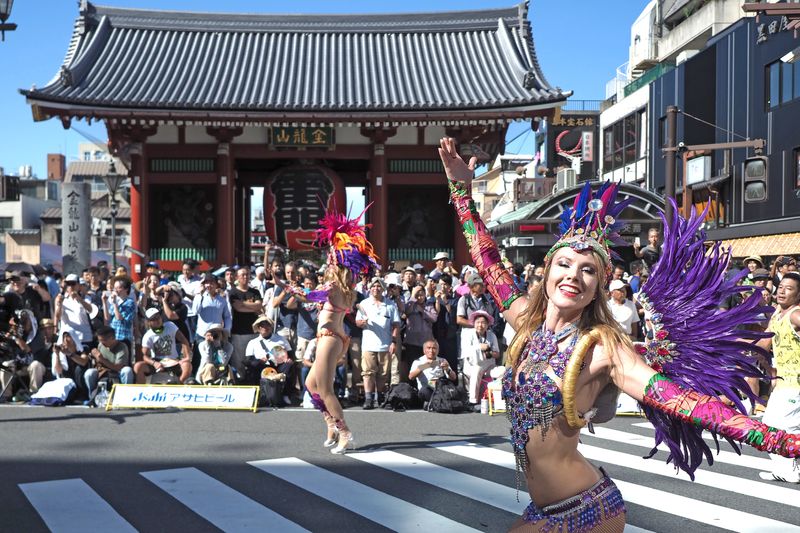
Seen by many as the swansong event bringing Taito City’s season of summer festivals to a close, the Asakusa Samba Carnival (浅草サンバカーニバル) certainly brings things to a colorful and vibrant climax.
While the idea of a Brazlian-style samba carnival might not sound very authentic, particularly given Taito City’s shitamachi setting, this event reflects the area’s ability to welcome and blend cultures and peoples from all walks of life, which is the shitamachi of today. Asakusa Samba Carnival also reflects the long and shared history of emigration between Japan and Brazil.
Visitors to the samba carnival regularly surpass half a million for an event which sees samba collectives drawn from around Japan swing their hips in flamboyant costumes as they accompany their wild floats along a course through the streets of Asakusa.
It’s an eye-popping spectacle, exacerbated by the delightful contrast of the shitamachi backdrop, as collectives compete for top honors in front of a panel of judges at the course end.
Festival insight
Given the spectacle the streets can get understandably crowded. Be in place early to see collectives passing by marquee sights such as Kaminarimon, or stay mobile to seek out opportunities when crowds thin out during gaps between passing floats. While dancers will be exerting the most effort, in the August temperatures even spectating can bring you out in a sweat.
More details: https://authentic-tokyo.com/event/detail?event_id=1000064?referrer=cc_article
This article was supported by Visit Authentic TOKYO, presented by Taito City




0 Comments